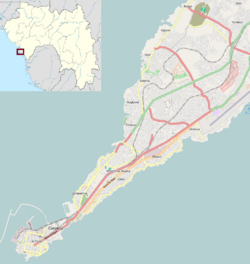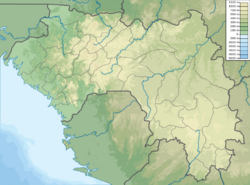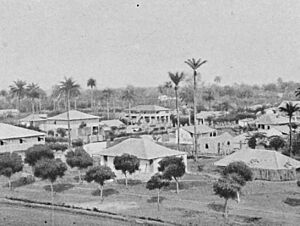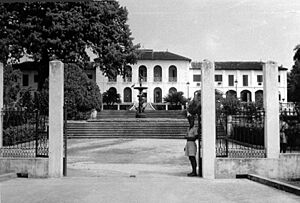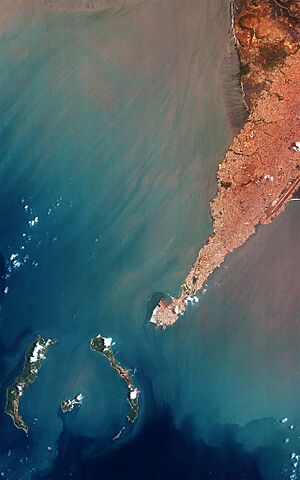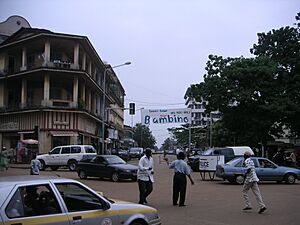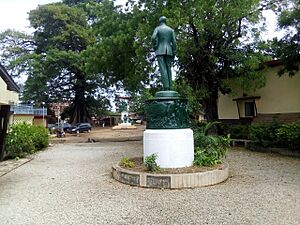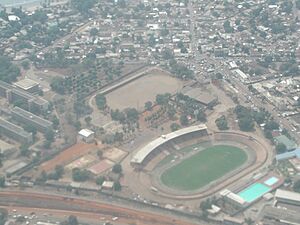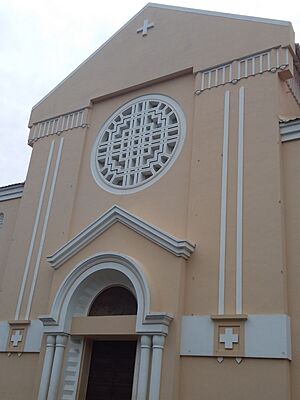Conakry facts for kids
Quick facts for kids
Conakry
|
|||
|---|---|---|---|

Skyline of Conakry
|
|||
|
|||
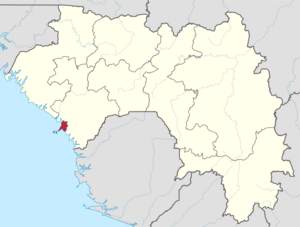
Conakry Region in Guinea
|
|||
| Country | |||
| Region | Conakry Region | ||
| Area | |||
| • Total | 450 km2 (170 sq mi) | ||
| Population
(2014)
|
|||
| • Total | 1,660,973 | ||
| • Density | 3,690/km2 (9,560/sq mi) | ||
| Demonym(s) | Conakryka | ||
| Time zone | UTC±0 (UTC) | ||
| • Summer (DST) | not observed | ||
| HDI (2022) | 0.660 medium· 1st of 8 |
||
Conakry is the capital and largest city in the country of Guinea. It is a very important port city, meaning it has a large harbor where ships can load and unload goods. Conakry is the main center for business, money, and culture in Guinea.
In 2014, about 1.6 million people lived in Conakry. Today, some estimates suggest the population is even higher, possibly around two million. This means that about one out of every six people in Guinea lives in Conakry!
Contents
History of Conakry
Conakry started as a small settlement on Tombo Island. Over time, it grew and spread onto the nearby Kaloum Peninsula. This peninsula is about 36 kilometers (22 miles) long.
The city officially began after Britain gave Tombo Island to France in 1887. Before that, in 1885, the two small villages of Conakry and Boubinet on the island had fewer than 500 people.
Conakry became the capital of French Guinea in 1904. It grew quickly as a port for exporting goods. A railway was built to Kankan, which helped transport products like peanuts from inland areas to the port for shipping.
After Guinea became independent in 1958, Conakry's population grew very fast. From 50,000 people in 1958, it jumped to 600,000 by 1980. Today, it has over two million residents. The city's small land area, being mostly on a peninsula, has made it challenging to build enough roads and other important services as it grows.
In 1970, there was a military event near Conakry. Forces from neighboring Portuguese Guinea (now Guinea-Bissau) landed near the city. They freed some prisoners of war before leaving.
Geography
Conakry was first built on Tombo Island, which is one of the Îles de Los. Since then, the city has expanded onto the nearby Kaloum Peninsula.
Climate
Conakry has a tropical monsoon climate. This means it has two main seasons: a very wet season and a very dry season.
The dry season lasts from December to April. During these months, a wind called the harmattan blows, bringing almost no rain.
The wet season, however, brings a lot of rain. In July and August, Conakry gets over 1,100 millimeters (43 inches) of rain each month! The total rainfall for the year is almost 3,800 millimeters (150 inches). Even with all that rain, the dry season is still very dry, with almost no rain in January and February.
| Climate data for Conakry (1991–2020) | |||||||||||||
|---|---|---|---|---|---|---|---|---|---|---|---|---|---|
| Month | Jan | Feb | Mar | Apr | May | Jun | Jul | Aug | Sep | Oct | Nov | Dec | Year |
| Mean daily maximum °C (°F) | 31.6 (88.9) |
31.9 (89.4) |
32.2 (90.0) |
32.3 (90.1) |
31.9 (89.4) |
30.3 (86.5) |
28.8 (83.8) |
28.4 (83.1) |
29.5 (85.1) |
30.4 (86.7) |
31.4 (88.5) |
31.8 (89.2) |
30.9 (87.6) |
| Daily mean °C (°F) | 26.9 (80.4) |
27.6 (81.7) |
28.2 (82.8) |
28.4 (83.1) |
28.3 (82.9) |
27.0 (80.6) |
25.9 (78.6) |
25.7 (78.3) |
26.3 (79.3) |
26.8 (80.2) |
27.7 (81.9) |
27.6 (81.7) |
27.2 (81.0) |
| Mean daily minimum °C (°F) | 22.3 (72.1) |
23.2 (73.8) |
24.1 (75.4) |
24.6 (76.3) |
24.6 (76.3) |
23.6 (74.5) |
23.1 (73.6) |
23.1 (73.6) |
23.2 (73.8) |
23.2 (73.8) |
24.1 (75.4) |
23.3 (73.9) |
23.5 (74.3) |
| Average precipitation mm (inches) | 2.5 (0.10) |
1.4 (0.06) |
3.4 (0.13) |
17.9 (0.70) |
112.5 (4.43) |
433.6 (17.07) |
1,082.6 (42.62) |
1,142.1 (44.96) |
555.2 (21.86) |
293.2 (11.54) |
80.0 (3.15) |
5.5 (0.22) |
3,729.9 (146.85) |
| Average precipitation days (≥ 1.0 mm) | 0.3 | 0.2 | 0.5 | 2.0 | 8.5 | 19.2 | 26.4 | 28.2 | 23.0 | 17.0 | 5.2 | 0.4 | 130.9 |
| Average relative humidity (%) | 71 | 70 | 68 | 70 | 74 | 81 | 85 | 87 | 85 | 81 | 79 | 73 | 77 |
| Mean monthly sunshine hours | 223 | 224 | 251 | 222 | 208 | 153 | 109 | 87 | 135 | 189 | 207 | 214 | 2,222 |
| Source: NOAA (humidity, sun 1961–1990) | |||||||||||||
Population
| Historical population | ||
|---|---|---|
| Year | Pop. | ±% |
| 1958 | 78,388 | — |
| 1983 | 710,372 | +806.2% |
| 1996 | 1,092,631 | +53.8% |
| 2014 | 1,660,973 | +52.0% |
| source: | ||
Economy
Conakry is the biggest city in Guinea and its main center for government, communication, and business. The city's economy mostly depends on its port. This port has modern facilities to handle and store goods. Through it, products like alumina (used to make aluminum) and bananas are shipped out to other countries.
Factories in Conakry make food products, cement, metal items, and fuel products.
Markets
- Marché Madina
- Marché du Niger
City Challenges
Since 2002, people in Conakry have often faced problems with electricity and water supply. Officials say this is due to droughts and old equipment. However, some people believe it's also due to how the services are managed. As of 2007, many parts of the city did not have working traffic lights at night.
These shortages have sometimes led to public frustration.
Transportation
Conakry has an airport called Conakry International Airport. You can fly from here to several cities in West Africa and Europe.
Architecture
- Palais Mohammed V
- Presidential Palace
- Palais du Peuple
Hospitals
- Donka Hospital
- Ignace Deen Hospital
- Clinique Ambroise Paré
- Clinique Pasteur
Culture
- Sandervalia National Museum
- National Library of Guinea and National Archives of Guinea
- Monument du 22 Novembre 1970
Places of worship
Conakry has many places of worship for different religions. For Islamic followers, there is the Grand Mosque of Conakry. For Christians, there are churches like St. Mary's Cathedral, Conakry, which belongs to the Roman Catholic Archdiocese of Conakry. Other Christian churches include the Église Protestante Évangélique de Guinée and the Assemblies of God.
Universities and education
- Collège Gbessia Centre
- Collège-Lycée Sainte-Marie
- Gamal Abdel Nasser University (Institut Polytechnique de Conakry)
- Institut Géographique National (Guinea)
- Université Kofi Annan
Parks and gardens
- Jardin 2 Octobre
- Conakry Botanical Garden
Notable people
- Hadji Barry, professional footballer
- Mamadi Diakite, NBA basketball player for the New York Knicks
- Maciré Sylla, singer, dancer, author and composer
- M'Mahawa Sylla is a Guinean army officer.
See also
 In Spanish: Conakri para niños
In Spanish: Conakri para niños




